These Kefir Milk Einkorn Tangzhong Buns are fluffy and creamy due to the addition of kefir-milk and tangzhong (water roux).
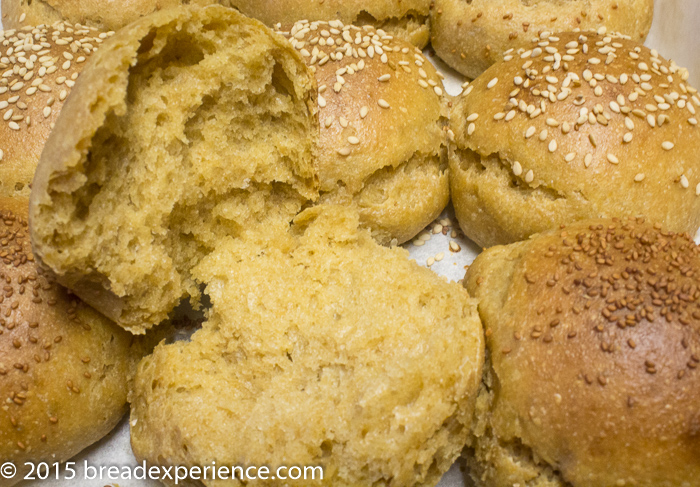
I’ve been reading more about the benefits of Einkorn so I decided to start experimenting with it again. I still have other grains that I enjoy, but I do love working with Einkorn.
I also enjoy using the tangzhong method. It seems that a lot of other bakers do as well. Over the past few weeks, I’ve been watching different types of tangzhong bread cycle through my FB feed. It’s very inspiring to see all of the creative breads from other bakers. Some of the breads I’ve seen recently have been made with tangzhong and sourdough.
I wanted to try this method and use a sourdough starter instead of yeast, but I had just cultured some kefir milk so I decided to use it in this bread instead of sourdough.
I incorporated sifted and unsifted freshly-milled whole grain Einkorn flour so the inclusion of a water roux helped to soften and enrich the dough and the kefir milk was used to ferment and provide structure for the dough. I substituted the regular milk one-for-one with the kefir milk and reduced the amount of yeast so the dough could benefit from an overnight retard in the refrigerator without overproofing.
After experimenting with the kefir milk method several times, I’ve found that the dough does need a bit of yeast; however, if you let it ferment in the refrigerator longer (24-48 hours), you can reduce the amount of yeast even further.
I took these rolls fresh from the oven to a dinner party so I had limited time to set up a photo shoot, but I think you get the gist.
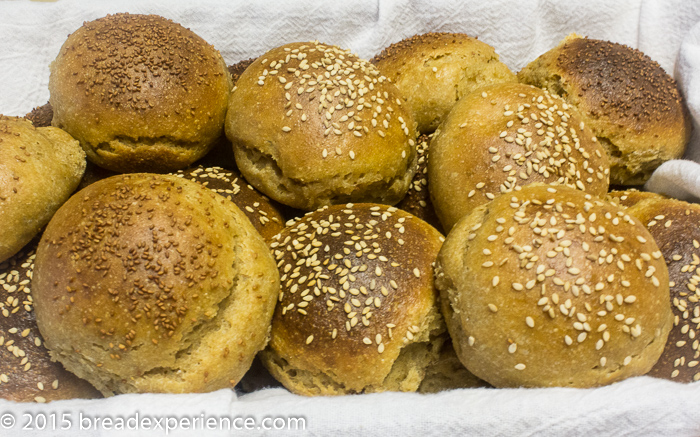
Since I was bringing these rolls to a dinner party, I doubled the following recipe to yield 24 rolls. I reduced the amount of sugar to 60 grams (instead of 80 which was the doubled amount). I was running out of time so I rushed the final proof. I think they could’ve proofed a bit longer which is why they cracked. However, the cracks in the buns ended up being perfect for the party because the hostess served sliced meats and everyone used the rolls to hold the meat. So the cracks facilitated an easier way to split them apart. Who knew?
The rolls were a huge hit at the party. I was so thrilled! Several of the guests asked to take some home so I knew they weren’t just saying they liked them to please me.
The recipe for these rolls is adapted from these tangzhong breads:
Equipment needed:
- Mixing bowls – various sizes
- Danish dough whisk or large wooden spoon
- Wire whisk for stirring the water roux
- Small pan for cooking water roux
- Sifter for sifting out a portion of the whole grain Einkorn flour (optional)
- Plastic dough scraper or spatula for scraping down bowl
- Bench knife for dividing the rolls and lifting dough
- Parchment paper or silpat for lining baking pan
- Square or rectangle baking pan (depending on how many rolls you make)
- Cooling rack
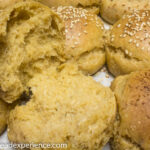
Fluffy Kefir Milk Einkorn Tangzhong Buns
- Yield: 12 Rolls 1x
Description
These Kefir Milk Einkorn Tangzhong Buns are fluffy and creamy due to the addition of kefir-milk and tangzhong (water roux).
Ingredients
Tangzhong mixture
- 25 grams all-purpose Einkorn flour
- 125 grams water
Final Dough
- 140 grams kefir milk (or regular milk, if preferred)
- 45 grams whisked eggs (about one large egg)
- all of the tangzhong above
- 40 grams organic sugar
- 5 grams sea salt
- 200 grams whole grain einkorn flour (sifted once)
- 150 grams whole grain einkorn flour (unsifted)
- 3/8 teaspoon instant yeast
- 40 grams unsalted organic butter
- Milk for brushing
- Seeds for sprinkling (sesame, poppy, etc.)
Instructions
Day One:
Making the Tangzhong Mixture:
- Mix the flour and water together until there aren’t any lumps.
- Cook, stirring constantly, until the mixture thickens and registers 149 degrees F or 65 degrees C. If you don’t have a thermometer, look for lines in the mixture made by your spoon as you stir. Remove from the heat immediately.
- Scrape the mixture into a bowl, and cover with plastic wrap, pressing it onto the surface of the tangzhong. Let it cool, and then refrigerate it for several hours.
- Bring it back to room temperature when you are ready to use it.
Mixing the Final Dough:
- Whisk the dry ingredients together in a large bowl.
- Add the wet ingredients and mix using a Danish dough whisk or wooden spoon.
- When the dough is to heavy to mix with the spoon or dough whisk, perform the fold-and-turn-method in the bowl until there are no dry flour bits.
- Work the butter in using your fingers until it is thoroughly incorporated in the dough.
- Place the dough in a clean, lightly greased bowl and turn to coat the dough. Cover the bowl with plastic wrap.
- Let the dough rise in the bowl for 1 – 2 hours, with a fold every 20 minutes for a total of 3 folds. Then let it rest in the bowl for 30 minutes before placing the dough in the refrigerator overnight for a cold ferment.
Day Two:
- Take the dough out of the refrigerator and let it warm up to room temperature for about 1 hour.
- Divide the dough into 12 equal pieces and shape them into rolls.
- Place the rolls in parchment-lined baking pans sprinkled with the bran you removed during the sifting process or use cornmeal if you prefer.
- Brush the tops of the buns with milk and sprinkle with the seeds of your choice.
- Proof for 1-2 hours or until doubled in size.
- Preheat the oven to 350 degrees F.
- Bake the buns for 20 minutes. Rotate the pan halfway the bake cycle to promote even baking.
- Remove to a wire rack to cool slightly before serving.
Notes
The dough for these buns can be made prepared in a stand mixer, however, when using Einkorn, it’s best to go light on the mixing and give it a longer rise in the bowl. Which is why I prefer to mix them by hand.
- Category: Bread Buns
- Tangzhong (water roux)
- Sifted Whole Grain Einkorn
- The sifted out bran
Happy Baking!
Cathy
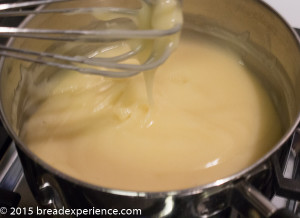
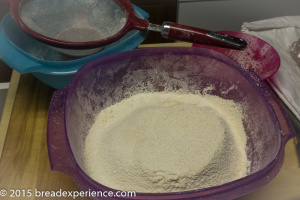
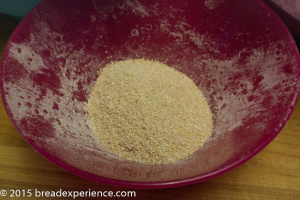

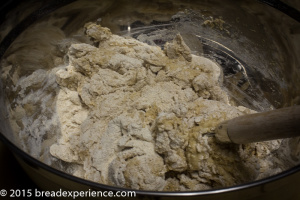
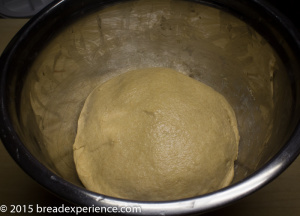
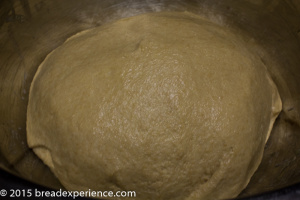
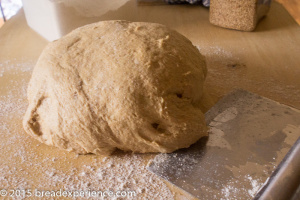
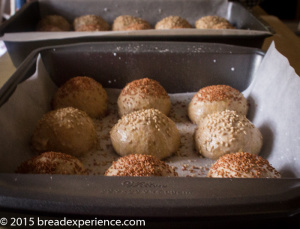
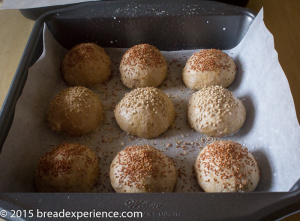
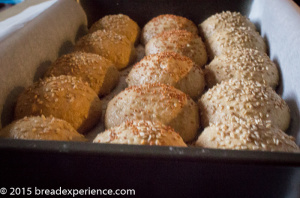
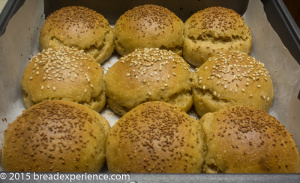
Janice Lim says
Your buns look lovely! Do you know what adjustments I might need to make if using all-purpose einkorn flour?
Cathy says
Hi Janice,
If you use all-purpose einkorn, you’ll most likely need less hydration. I would reduce it by 20% to begin with and then add it back in gradually, if needed. And, if you use regular milk instead of kefir milk, you might need to increase the amount of dried yeast to 1/2 teaspoon.
Janice says
ok, thanks, Cathy!
Gina says
Hi Cathy Thank you for this recipe, it’s just what I was looking for because I have more kefir than I know what to do with. It’s just two of us who will be eating these rolls so I’m wondering if you know whether I can freeze the dough after it has been divided into the 12 pieces? Thank you for your time and expertise. I’m very much a beginner.
Cathy says
Hi Gina, I understand about the need to use up Kefir.
I have not tried freezing the dough balls after shaping so I don’t know how that would work.
I’m wondering if you might want to bake the rolls and freeze the extra rolls instead of the dough balls. If you wrapped the rolls really well so they are airtight, they would probably freeze okay for a little while anyway. Then you could just take them out when you need them, wrap them in foil, and warm them in the oven – or a toaster oven.
Gina says
Wow, thank you for the quick reply. I am ready to get started and was so happy to see your brilliant reply. I don’t know why I didn’t think of that! You’re absolutely right. So much more convenient to bake them first and then freeze them. Thanks again Cathy.
Cathy says
Happy Baking! Do let me know how they turn out!